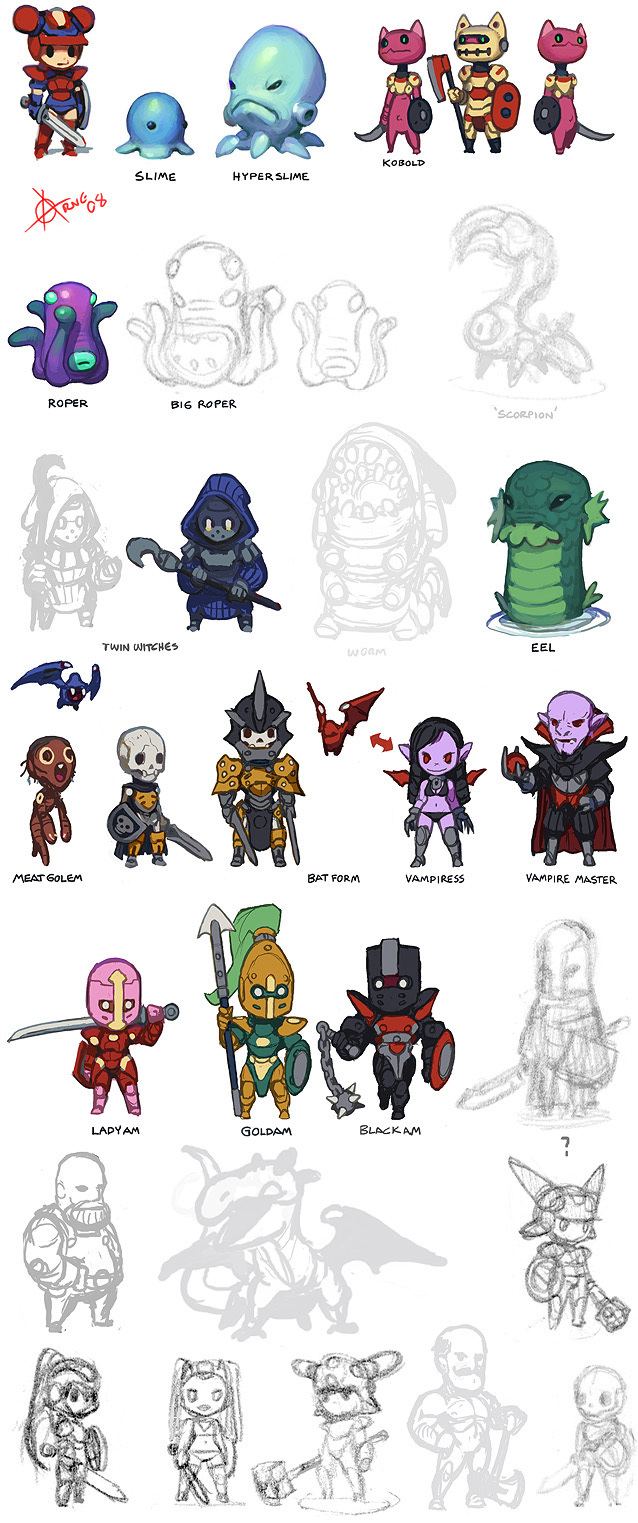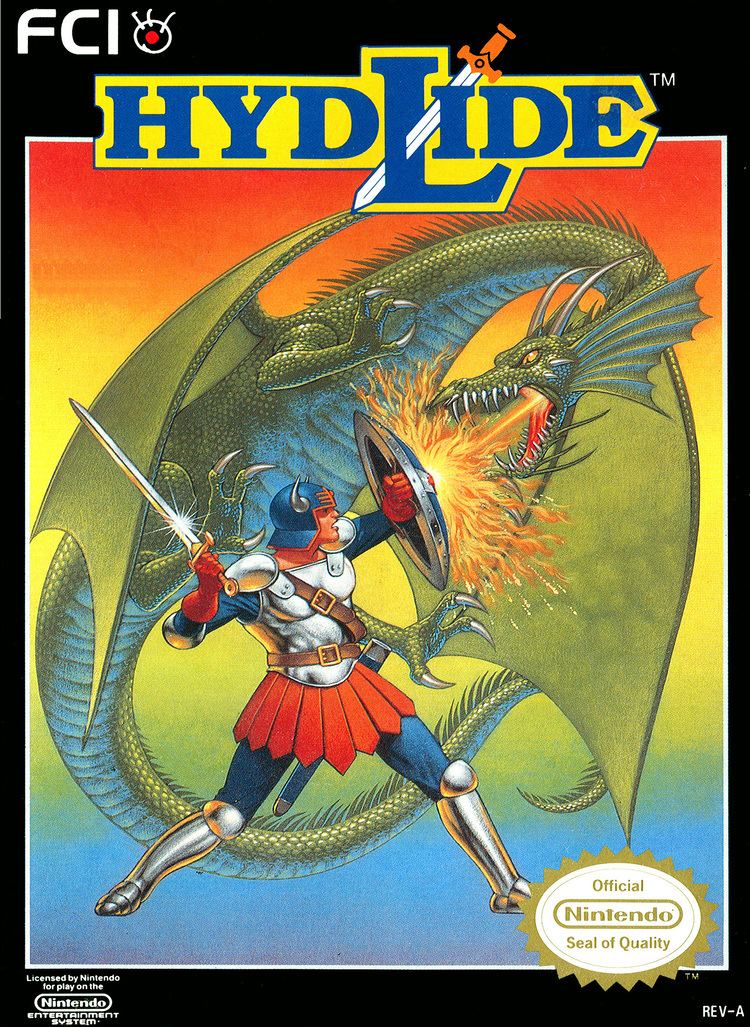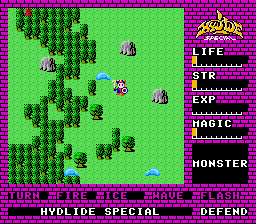Designer(s) Tokihiro Naito Initial release date 13 December 1984 | Programmer(s) Eiji Kato Genre Action role-playing game | |
Developer Technology and Entertainment Software Platforms Nintendo Entertainment System, MSX, PC-8800 Series, PC-9800 series, X1, FM-7, NEC PC-6001, Sharp MZ, MSX2 Publishers Technology and Entertainment Software Similar Technology and Entertainment Software games, Action role-playing games | ||
Hydlide angry video game nerd episode 86
Hydlide (ハイドライド, Haidoraido) is a 1984 open world action role-playing video game developed and published by T&E Soft. It was originally released for the NEC PC-6001 and PC-8801 computers in 1984, in Japan only; ports for the MSX, MSX2 (a separate port released on 3.5" floppy), FM-7 and NEC PC-9801 were released the following year. A Nintendo Famicom version was first released under the name Hydlide Special on March 18, 1986 in Japan; three years later, in June 1989, that version saw a North American release for the Nintendo Entertainment System by FCI, its title having been returned to simply Hydlide. The game sold 2 million copies in Japan, across all platforms.
Contents
- Hydlide angry video game nerd episode 86
- Hydlide projared
- Storyline
- Characters
- Development
- Reception and legacy
- Sequels
- References

In April 28, 1995, a remake was released for the Sega Saturn under the title Virtual Hydlide, both in Japan and western countries.

Hydlide projared
Storyline

In the kingdom of Fairyland, three magic jewels were enshrined in the palace to maintain peace in the kingdom. One day, an evil man broke into the palace and stole one of the three magic jewels. Without the third jewel, the two remaining jewels lost their magic sparkle. The magic spell that sealed the power of Varalys, the most vicious demon in the kingdom, was broken. During the turmoil which followed, the last two jewels were stolen. Varalys cast a special magic on Princess Ann, turning her into three fairies, and hid her somewhere in the kingdom. He then let loose a horde of monsters across the land and became the ruler of the kingdom.
The young knight Jim stood up and took action to restore peace in the kingdom. He bravely made his way into the wilderness in full armor to fight the monsters...
Characters
Development

The game was created by T&E Soft's Tokohiro Naito. His idea behind Hydlide was to mix together action and RPG elements into a new "action RPG" genre. He was inspired by The Tower of Druaga and The Black Onyx, but said that The Black Onyx was not a direct influence, as Hydlide's design leans more towards action rather than role-playing. Hydlide essentially took The Tower of Druaga formula to a colorful open world, and added RPG mechanics.

Naito noted that he was completely unaware of Western role-playing games like Ultima and Wizardry when he was developing Hydlide, as he had never used the Apple II before. He said that he only became aware of two other Japanese action RPG projects, Dragon Slayer and Courageous Perseus, while reading a magazine during Hydlide's development, and was shocked to find that Hydlide was not the only attempt at the concept. He underestimated Dragon Slayer but felt threatened by Courageous Perseus, believing the latter to be more visually impressive; Courageous Perseus turned out to be not as successful, whereas Dragon Slayer went on to become Hydlide's biggest competitor, through subsequent sequels.
Reception and legacy
Hydlide was initially well received and considered an innovator when released in Japan back in 1984. Hydlide was one of the first action role-playing games, along with Courageous Perseus and Dragon Slayer. Hydlide was also an early open world game, rewarding exploration in an open world environment. It also had the ability to switch between attack mode and defense mode, quick save and load options which can be done at any moment of the game through the use of passwords as the primary back-up, and the introduction of a health regeneration mechanic where health and magic slowly regenerate when standing still.
It sold 2 million copies in Japan, including 1 million for home computers (including the PC-88, PC-98, PC-66, Sharp X1, FM7, MSX, MSX2, and MZ-2000) and 1 million for the Famicom console. It was the first computer game to receive a Platinum award from Toshiba EMI for a million sales. However, it failed to capture the same attention beyond Japan.
The game was influential on the action RPG genre, including titles such as The Legend of Zelda and Ys. For example, Ys uses a similar health-regeneration mechanic. The recharging health mechanic first introduced by Hydlide in 1984 would, decades later, become a common mechanic widely used in many video games, including shooter games such as Halo. Hydlide's open world game design inspired Hideo Kojima, who designed Metal Gear Solid V so that it captures the open-world feel he felt when he first played Hydlide on PC. Platinum Games director Hideki Kamiya was inspired by the Hydlide series, which he cited as an influence on Scalebound, an open world action RPG.
Hydlide was initially released outside of Japan through the European release of the MSX version. Beyond that, 1989 saw the release of a localization of Hydlide Special for the NES, simply titled Hydlide itself. Being released years after the fact, this release was treated as a brand new game. It received a negative reception, often compared unfavorably to The Legend of Zelda (1986), which had improved significantly upon Hydlide. The NES version of Hydlide became infamous in the West for its repetitive background music that bears similarity to John Williams' Indiana Jones theme. The repetitive nature is because it is one of the only two RPG/Adventure games made for the Family Computer (NES) without bankswitched memory; the other, Enix's adventure game PORTOPIA Renzoku Satsujin Jiken, has no music at all.
Sequels
Hydlide had several follow-ups:
